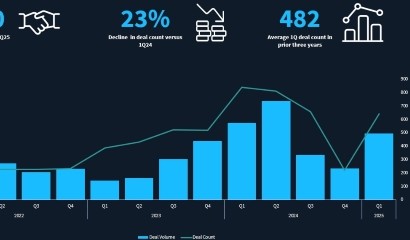Healthcare restructuring set for another busy year
Reimbursement challenges and high labor costs are expected to continue to drive restructuring activity among healthcare companies this year after a busy 2023.
“We see the pipeline here as being fairly robust in terms of both healthcare services and pharmaceuticals,” said Daun Chung, Managing Partner at MTS Health Partners. Whether there are liability management transactions to buttress liquidity and extend maturities or broader restructurings, 2024 is setting up to be just as active in the restructuring space as 2023, if not more active, he said.
Companies on the services side of the healthcare industry have been especially vulnerable to reimbursement and labor inflationary cost pressures. Already this year, several healthcare groups have gone to market with liability management exercises to tackle upcoming maturities and raise liquidity.
Physicians practice group Radiology Partners is looking to raise at least USD 300m of preferred equity to facilitate a deal with lenders to extend 2025 debt maturities. AccentCare, meanwhile, is in the market to secure a new USD 175m super priority facility backstopped by existing first lien lenders.
Ratings agencies said in recent reports that both companies have struggled with high labor costs and reimbursement issues with AccentCare in particular hit by rate cuts from Medicare.
Last year 50 healthcare companies with liabilities over USD 10m filed for bankruptcy, double from 25 bankruptcies in 2022, according to Debtwire data. Envision Healthcare was the largest filing of the year with USD 9.4bn in debt, followed by pharma group Mallinckrodt at USD 3.6bn and medical transport provider Air Methods with USD2.2bn.
Clare Moylan, co-founder of healthcare advisory firm Gibbins Advisors, said she expects increased bankruptcy activity will continue in 2024.
Moylan said 2023 was the most active year for healthcare bankruptcies in five years with senior care and pharmaceutical subsectors comprising almost half the total healthcare bankruptcies. Filings with liabilities over USD 100m surged in 2023, reaching 28 filings compared to only seven in 2022 and eight in 2021, according to Gibbins data.
The number of hospital bankruptcies spiked in 2023 in large part because many COVID-19-related government protections came to an end, Moylan said. “Now there’s a natural level of distress that ultimately returns to the market, so we could see the elevated level of hospital bankruptcy filings that we saw in 2023 continue through 2024,” she said.
Last year marked the second year since the federal No Surprises Act—a law designed to protect patients from unexpected medical bills—took effect. Several companies that restructured last year, including Air Methods, American Physician Partners and Envision Healthcare, cited the act as one of the reasons why they filed for Chapter 11 bankruptcy protection.
For many companies, the act’s primary impact has been a change to the revenue cycle between when a healthcare group provides a service and collects payment, said a restructuring attorney who has worked on healthcare situations.
Thanks to the law, there is a large backlog in claims to process due to many claims going through the independent dispute resolution process. That poses a challenge for hospitals that don’t get paid while the claims are pending.
“The way that has changed the revenue cycle for healthcare providers has been a big source of distress,” the attorney said. “I think that will continue to be a source of distress for companies. Again, it’s not the act, but the way market players have reacted to the act and the way it’s changing the revenue cycle within the industry.”
Such headwinds have existed within the space for some time, said Paul Rundell, a managing director with Alvarez & Marsal’s North American Commercial Restructuring practice.
“It all has to do with reimbursement,” Rundell said. “Because the companies that are having issues are big and public, people think it’s new. It’s new for the subsector, but it’s not new for healthcare.”
Dentistry is another area of the market under pressure. Financial sponsors rolled up dozens of dental practices in recent years under dental support organizations, but the popular strategy sometimes runs into problems—as in the cases of Great Expressions Dental Centers and Jefferson Dental last year.
Jacob Czarnick, a managing director at Raymond James, said he expects restructuring activity among overleveraged roll-ups this year due to reimbursement pressures coupled with increased labor costs and softness in demand.
Dwindling earnings from lower patient volume has been jeopardizing issuers’ liquidity and their ability to refinance their debt, Czarnick said
Rundell said he expects to see restructuring activity pick up in acute hospitals and capitated risk sharing healthcare companies and continue among small special purpose acquisition companies (SPACs) in areas like medical devices.
Medical technology company Surgalign is one such SPAC that filed for Chapter 11 last year after being battered for years with litigation stemming from intellectual property claims and other lawsuit liabilities.
Capitated risk sharing companies stand to gain if they can deliver efficient care to patients, but unexpected costs or sicker patients pose a risk. Some firms have been hit by an uptick in patients seeking care deferred during the pandemic and increasing cost of providing care, said Rundell.
Restructuring activity, meanwhile, will continue among pharmaceutical companies given the binary nature of outcomes for drug development, said Czarnick.
“I expect we’ll continue to see small and mid-sized pharmaceutical companies restructuring with 363 sales dominating,” he said.
Mallinckrodt, Infinity Pharmaceuticals, Tricida and Timber Pharmaceuticals are among the number of pharmaceutical companies that filed in 2023.











